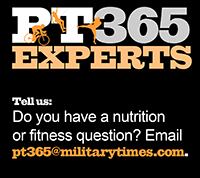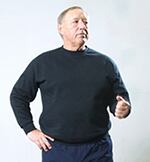This workout focuses on making you a stronger swimmer. But by doing the exercises — and eating a healthy diet — it will improve your look, too. These six exercises work the body from feet to shoulders. (Triathletes will agree there needs to be a seventh exercise on how to survive the trampling that occurs during the swim portion of a race.) Do 10 reps on everything, and dream of the nice warm days ahead while working on these exercises.
Tate press
You can really feel your triceps flex on this one; also hits the forearms and wrists.
Lie on your back on a flat bench with two dumbbells, in the vertical position, resting on your chest and touching each other. Palms are facing your feet, and knuckles are pointed towards each other.

Straighten your arms, keeping the dumbbells in contact with each other.
At halfway, rotate the dumbbells from vertical to horizontal while maintaining contact.
At the finish, arms will be extended and knuckles will be pointed up.
Reverse the movement back to the start.
Standing straight-arm pulldown
This one focuses on the swim pull throughout the entire range of motion. Use a cable machine with a straight bar or tubes.
Set the handle grip above your head so that arms are extended at 45 degrees from vertical at the start. Elbows should have a slight bend.
Pull the bar down toward your thighs in an arcing motion, stopping just short of your thighs, and slowly return to the start.
Keep the elbows bent throughout.
Standing Zeus
This ties together the movement of the shoulder, arms and trunk. Use a cable machine with stirrup handle or tubes.
You either can face the handle (grasp handle with either hand), or to get more trunk rotation, stand at 45 degrees to the handle (grasp handle with back-arm palm facing down). My preference is to do this with the body at 45 degrees to the handle, unoccupied hand at your side, rather than both hands up.
Pull the handle toward your chest while rotating 1) the handle to thumb facing up and 2) your trunk backward.
As you execute the pull, bring your other arm through to the 45-degree extended position.
Reverse both motions to return to the start.
Staggered medicine ball pushup
Staggered hand placement adds a challenge to the hand on the medicine ball and increases demand on the core.
Use a single medicine ball. Start with hands shoulder-width apart, one hand on the ball and the other on the floor.
You must hold your body in a straight line with arm on the floor fully extended. The arm on the ball will have a slight flex.
Lower your body until your chest is even with or lower than the top of the ball. Return to the full up position. After the required number of reps, repeat on the other arm.
Bulgarian squat
Isolating one leg at a time can address any muscle imbalance as well as overall balance.
Hold a moderate-weight dumbbell in each hand. Stand at least two feet in front of a flat bench, with your back to the bench. (You may have to adjust further out prior to the first rep so that the knee stays over the toes during the squat.)
Reach back with one leg and rest that foot on the bench.
Lower your body slowly until the thigh of the standing leg is almost parallel. Return to the starting position and repeat, then switch legs.
Kettlebell/dumbbell swings
This is a total-body chain exercise that keeps the load light on the back.
Start with a light kettlebell/dumbbell to learn technique, then increase weight. Feet are about shoulder-width apart, shoulders pulled back. Grasp the handle of the kettlebell and hold between your legs. (Using a dumbbell, I prefer to grasp it by one of the weight plates rather than the handle.)
With a slight flex to the knees, hinge forward at the hips until your back is about 45 degrees from vertical (but still flat). The kettlebell/dumbbell will position slightly behind your knees.
Drive your hips forward, keeping arms extended. This will drive the kettlebell out, and you'll come to a standing position. Bring the kettlebell up to about eye level, then let momentum turn back toward the bottom and repeat. Keep your head up and looking forward.
It's critical that you drive the kettlebell/dumbbell upward by firing the hips, not your back. Another tip: When you're in the bottom part of the swing with the weight between your legs (after the first swing, the weight will be behind your legs), you should feel like you're at the ball-release point in hiking a football. Check out a YouTube video to see the movement.
___________________

Retired Navy Cmdr. Bob Thomas has been our Military Muscle columnist since 2007. He's the director of the Navy Wellness Center in Pensacola, Fla. He's his base's lead trainer, a wounded warrior program facilitator and the Navy nutrition counselor there. His special emphasis is on fitness for the military retired population. Find his Military Muscle columns here.





